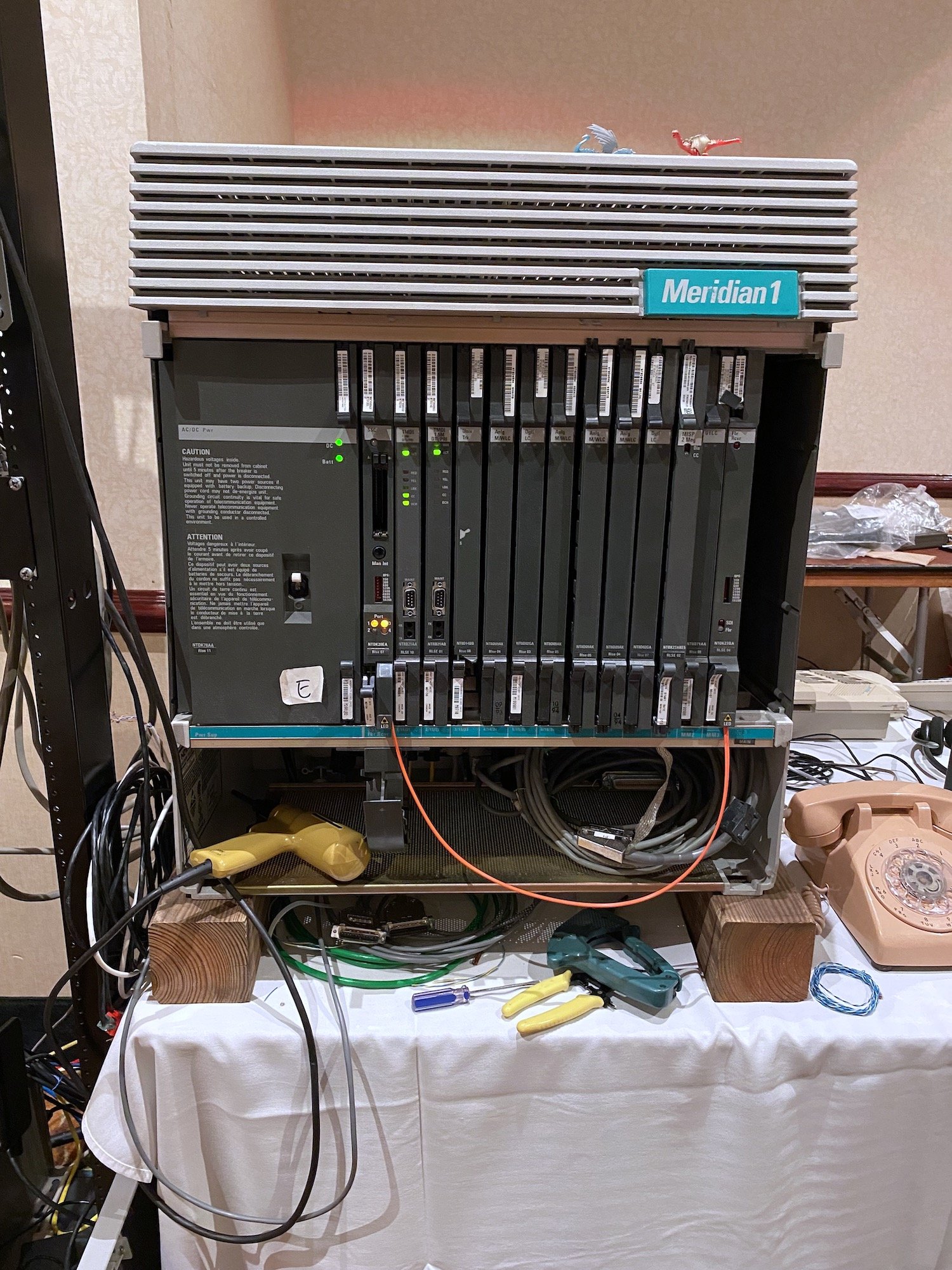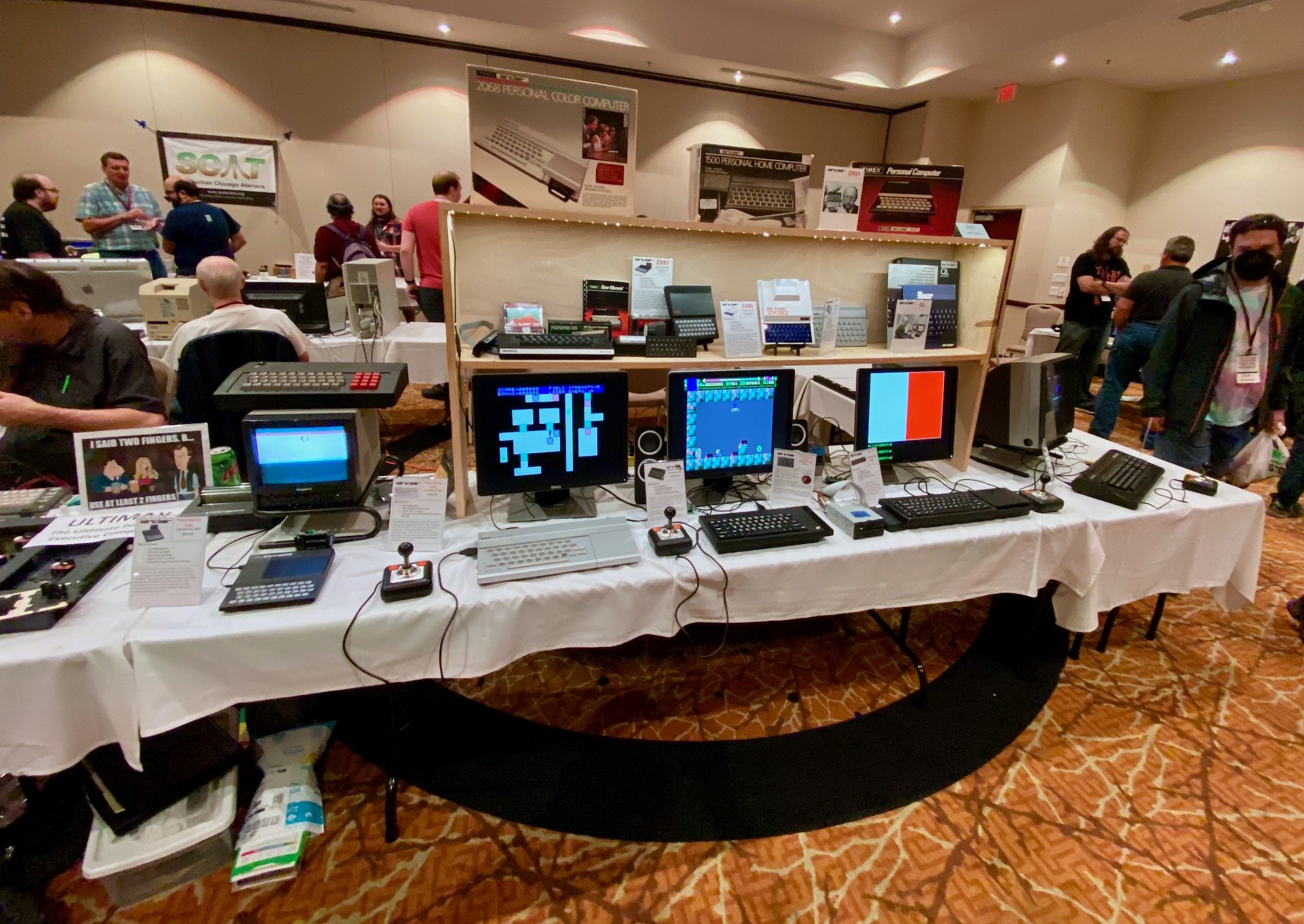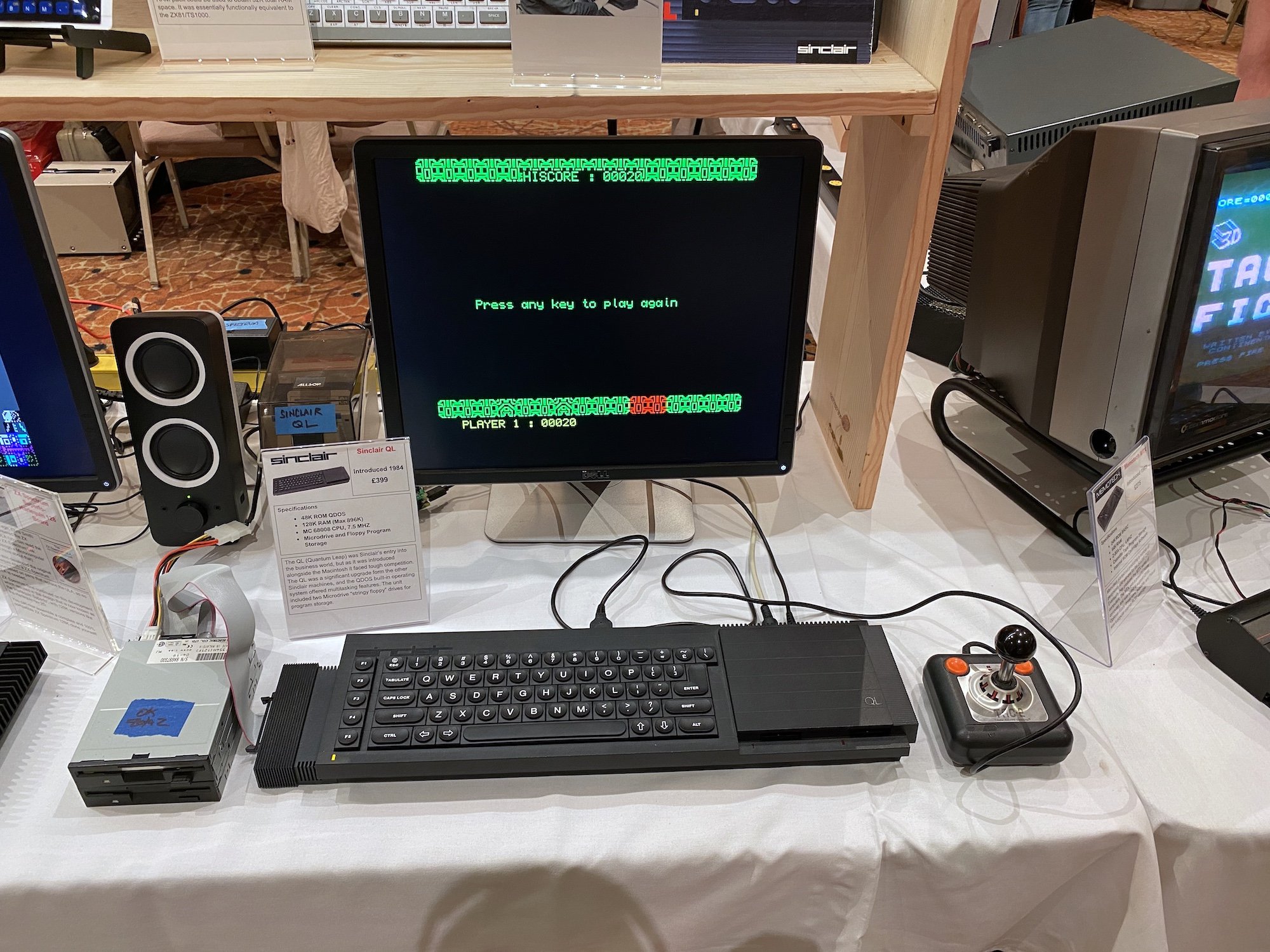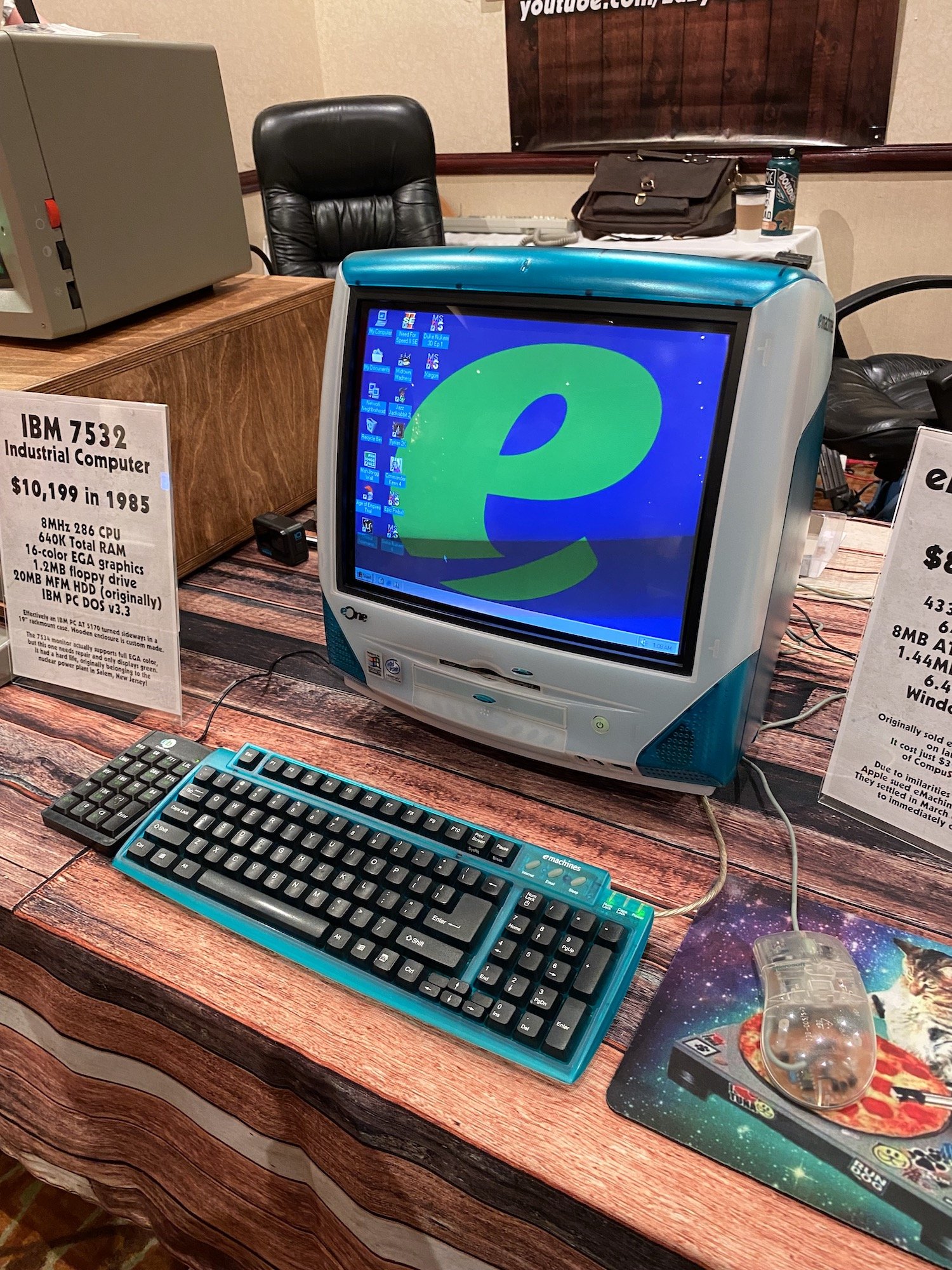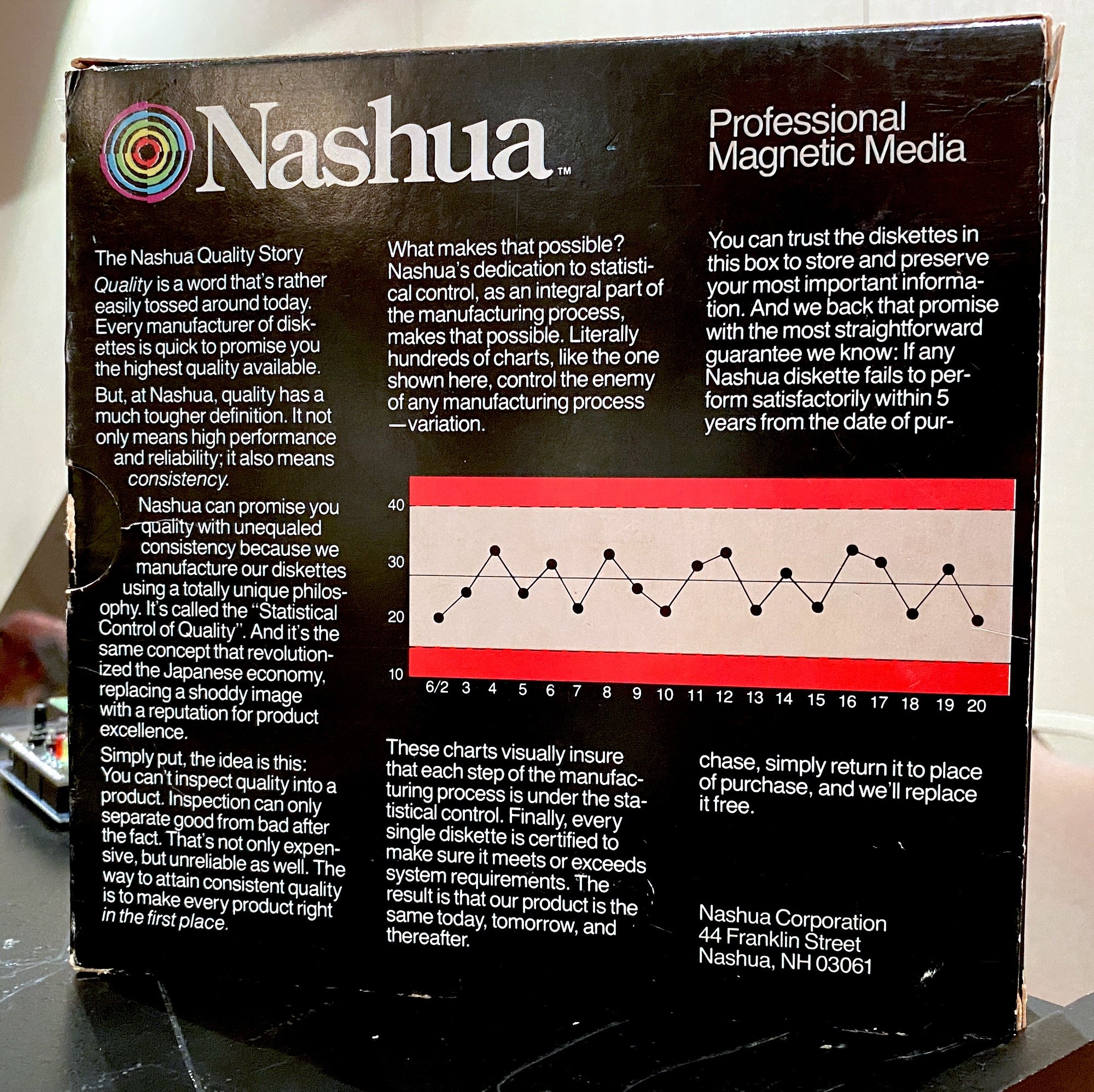The 2022 Vintage Computer Festival Midwest Report
Here in Userlandia, my Windows color scheme is Portillo’s Hot Dog.
Hello, Chicago!
Hey everyone, I’m back from the 2022 Vintage Computer Festival Midwest, and I’ve got a mostly off-the-cuff podcast to discuss the ups and downs of the experience. VCF Midwest took place on the weekend of September 10-11 in Elmhurst, Illinois; a Chicago suburb just south of O’Hare Airport. After much prodding by my Chicagoland friend Mark, I booked a flight from Boston to Chicago to get my fill of retro served with a pickle, tomato, and sport peppers.
Despite the words “Vintage Computer Festival,' VCF Midwest isn’t actually related to VCF East or VCF West. Those two are put on by the Vintage Computer Federation, while VCF Midwest is a product of a separate group: Chicago Classic Computing. The two groups are friends that support each others’ events and have no desire to wage trademark war unlike, say, Comic Con International going after shows with “Comic Con” in their name. This is the seventeenth event under the VCF Midwest banner, but its origins stretch back beyond that to various Chicagoland user groups and exhibition orgs in the nineties.
The first thing I noticed about VCF Midwest is that it operates differently than other events. Most conventions I attend require some kind of admission fee at the door—VCF Midwest does not. Most conventions I table at require some kind of table fee—VCF Midwest does not. The show is funded entirely by cash donations, T-shirt sales, auction revenue, and its garage sale. We’ll get to what each of those means in a bit, but this revenue model makes VCF Midwest very much free as in beer. By foregoing any kind of fees or charges, the show tries to uphold the early microcomputer era’s ideals of openness and community.
Mark and I arrived early on Saturday morning—if you consider fifteen minutes before opening time early—and found a nearly full parking lot. Arriving early is important if you’re interested in buying stuff, because the vendor tables will have the most stock at that time. We also had a trunkful of items to donate to the auction, garage sale, and free pile, so we needed to unload the car ahead of prime browsing time. The event takes place at Elmhurst’s Clarion Inn and Waterford Banquet, a run-of-the-mill hotel with attached conference space. When entering the front door you’re greeted with the auction pile, check-in desk, and the vendor’s hallway. A large exhibition hall is divided into four rooms, three of which host the various exhibit tables and a fourth dedicated dedicated to panels.
A very busy opening hour.
After unloading the car and walking around the halls, my impression of the show was a feeling of organized chaos. After years of growth the venue seems to struggle with the number of people that show up on a Saturday. VCF Midwest’s website says over two thousand people showed up over the weekend, and I believe it. People crowding around vendor tables clashed with people streaming in and out of exhibit halls, and navigating the traffic was sometimes tricky. These jams were partially relieved by opening up the movable barriers and creating shortcuts inside the halls. People could cut across from room to room instead of having to exit and navigate the vendor hallway, which helped relieve those bottlenecks. As far as I know there wasn’t a printed schedule or information booklet—not even half-folded xerox copies. Thankfully cellular data was working well and we could check the schedule and exhibit list online.
Sometimes the distinction between exhibitor and vendor gets pretty blurry. Of course VIP guests would sell their branded merch, but I was a bit surprised to see museum-style exhibitions next to a table covered in boxes of random hardware and software. Speaking of that, let’s talk about the various exhibitors and all the neat stuff on the floor.
Exhibits
The exhibition hall was divided into three rooms: “Mostly Micros,” “Youtubers and More,” and “Big Iron.” One brand that had a lot of representation was Silicon Graphics. SGI machines were prominent in two of the three rooms, and seeing an Indigo and Onyx in person was a mesmerizing experience. Some were from System Source while others from Anthony Bolan, and their applications ranged from Maya demos to the requisite Nintendo 64 development kit. A few were running Irix desktops with productivity software and games. Even oddballs like the Tezro were on display. It’s been fifteen years since I’ve touched an Octane, and I still regret not taking it with me when it was retired. These SGI enthusiast groups are frequent guests to VCF Midwest, so if you want to see real SGI gear in person, you’ll want to make the trip.
A Meridian PBX System
A complete office PBX phone system with a Windows NT Telephony server anchored the Big Iron room along with the minicomputers and terminals. Two exhibitors, Dial 1 for IT and The Phone Company & More set up a switched phone network complete with real phones and fax machines. It was connected to the publicly switched telephone network too, so you could dial in with any phone and speak to someone right at the table. This phone setup was the most Rube Goldbergian contraption in the entire hall.
Along with old phones were plenty of old televisions! You might remember from my VCF East report that there’s enthusiast groups keeping old cable TV equipment alive, and one of them was at VCF Midwest. Behind the Screens had two tables chock full of your favorite ‘90s cable TV time wasters. On one side was a Weather Channel broadcasting setup with a Macintosh TV tuned to the forecast. Given that my Macintosh TV is currently inoperable, it was nice to see one working in the flesh. I talked with the fellow behind the table and clued him in to the fact that his Sony remote control could also control the Mac TV. His mind sufficiently blown, he thanked me for the tip and we talked about restoring one of the coolest flawed Macs. Next to their Weather Channel equipment was a Prevue Guide setup running on an Amiga, which was the real hidden gem of the show. The slow scroll of TV listings stopped me dead in my tracks. I haven’t seen a scrolling guide in almost twenty years, yet I felt like I was immediately transported back to my parents’ living room in a Ratatouille-like trance. Other attendees also fell under its spell—I guess that Saturday afternoon “What the Hell is on TV?” vibe is a universal one.
An Amiga 2000 hosting Prevue Guide.
Another great opportunity is experiencing computers and software that may have passed you by, and VCF Midwest had plenty of exhibits to fill in your blanks. Jeff Fetta had two tables full of Sinclair products, like various Spectrum and ZX computers. Another table run by Chris Ellmore had more British computers, including Acorn products. Japanese PCs were well represented, with multiple Sharp X68000s, NEC PC-88s, and a Casio Loopy MySeal. It’s a console… computer… thing? Danielle Herbert AKA thegirlgeek had it running some JRPGs I’ve never heard of with some very cute graphics.
Though Commodore had the most representation of the eight-bit brands, other popular systems of the eighties got their due as well. CoCoFest consumed a whole corner of one room with the largest collection of Tandy computers I’ve seen in one place. Atari users were represented by the funnily named SCAT, or the Suburban Chicago Atarians group. Add the aforementioned British micros and you’ll have hands-on with most of the major players of the eighties.
While there were plenty of IBM compatible computers spread across the floor, Big Blue got a lot of love from Joshua Conboy’s Warped! The end cap of the Mostly Micros room was a celebration of everything OS/2, with boxes, memorabilia, and a PS/2 running OS/2 Warp. Featuring games and productivity software, the display challenged you to experience a “better Windows than Windows.” I gave SimCity 2000 a run, only to find it unplayable because the mouse sensitivity was cranked to the maximum. I poked and prodded everywhere, frantically right-clicking through OS/2’s endless settings windows to find its version of Control Panel. After five minutes of flailing I finally discovered the mouse settings, adjusted the sensitivity, and was ready to go. I tabbed back into SimCity 2000 to build a quick town and, well, it’s SimCity 2000 all right. Other than OS/2 styled menus it plays exactly the same as the other versions. But OS/2 users had one big advantage over their Classic Mac or Windows 3.1 counterparts: if the game crashed, it wouldn’t bring the rest of the computer down with it.
And, of course, the VIPs had exhibits as well. These were personalities like Clint Basinger (LGR), David Murray (8-Bit Guy), and Ken (Computer Clan). Adrian Black from Adrian’s Digital Basement didn’t have a table, but he was roaming the floor talking to people. Mark told him the tale of a Mac Classic he resuscitated thanks to Adrian’s video about the reset line under the sound chip, much to Adrian’s amusement. These were some of the busiest tables at the show, and not just because of the celebrities. Each table had computers or items featured in their videos, which attracted lots of attention on their own. Ken’s NeXT cube got a lot of love, as did Clint’s eMachines iMac knockoff. If you’d never heard of their channels, you’d think they were just like any other exhibitor at the show—and that’s a good thing! But not all exhibitors are there just to show stuff off. Some were there to make some cash, and that’s where vendors come in.
Vendors, Auction, and Sales
Most of the pure vendors were lined up along the main hallway. The majority were people selling various old computers, hardware, and software. Some, like Bonus Life, are vintage resellers that fix machines to sell them at a markup. Others are collectors that are looking to divest themselves of pieces they don’t need anymore. Rounding out the selection are local groups like the Wisconsin Computer Club and the remnants of FreeGeek Chicago.
My favorite vendor that I couldn’t afford to buy anything from was MacEffects. They make the clear transparent Macintosh SE case that you’ve seen floating around. Clear Mac and Apple II cases were in stock, but they one upped themselves with their color cases. The Mac was available in red, green, and blue translucent acrylic, but the real star was the gloss black Apple II case. Unfortunately, gloss black plastic has a huge drawback: it shows every single fingerprint and a feather could scratch it. But for those few moments that you take it out of the box, it’ll be the coolest looking Apple II in the world. Take that, Bell & Howell!
Commander X16
Another favorite was the BlueSCSI team. It’s the hottest hard drive emulator in town, and you could buy your BlueSCSI either as a kit or preassembled. I bought preassembled external and internal versions, and they’ll be perfect for my various SCSI computers. Meeting the team in person further cemented my appreciation for the project, as their infectious enthusiasm comes through at every opportunity. I believe this is their first time tabling at a show, if my vague memories of Twitter are correct. The Commodore-centric group DDI had a full range of MagicCarts for various computers for sale, which allows you to load disk images without much fuss, or create custom ROMs. Seeing old machines and modern hardware working in harmony is the most exciting part of this scene, which is a big reason to go to this show. TexElec’s booth was showing off the Commander X16, which is a new 6502-based microcomputer. Think of it like a modern successor to the Commodore 64. Working examples were showing off games, and as of this writing I don’t know when it will be released. Still, they’ve clearly made a lot of progress.
In addition to actual vendors, the show also had what it dubbed “the garage sale” and “the free pile.” The free pile is exactly what you’d expect: anything there is up for grabs. Make sure to follow the ground rules—no uncool inkjet printers, you should give an item when you take an item, and don’t leave stuff behind when the show ends. Tons of cool stuff flowed through the free table, like a Dutch copy of ClarisWorks, various monitors, busted computers, a box full of webcams, and a pile of round mousepads. Stuff kept showing up as the days went on, so we were constantly checking it for new things. I nabbed a copy of PageMaker 3.0 for the Mac and Norton Utilities for Windows 95. The latter will probably be more useful, but that PageMaker came on 800K floppies which are pretty rare these days. I donated a Linux-based Sharp Zaurus PDA to the free table, and I hope whoever took it makes good use of the parts.
The free pile.
This Sun Server was a standout at the garage sale.
What about the garage sale? When visitors donate an item to the auction, it gets “graded,” which is a fancy term for “we decide if it’s interesting enough to generate a lot of bids.” Stuff that doesn’t make the cut gets tagged with a price and put on the garage sale table. I donated a set of new in box Packard Bell CRT monitor speakers to the garage sale. Mark donated some computers, NAS devices, and other doodads, some of which wound up in the auction. A minifridge-sized Sun server was the standout item, and yes, someone did buy it. Dozens of computers, monitors, accessories, and more moved through the garage sale during the weekend, generating much-needed money to fill the show’s coffers.
Items that do make the grade end up in the Saturday evening auction. Although head honcho Jason Timmons isn’t an actual auctioneer, he played the role so well that I thought he stayed at the Holiday Inn and not the Clarion Inn. Items ranged from voltmeters and oscilloscopes all the way up to an Amiga 2000, with many Macs, PCs, and doodads from every era of computing up for grabs. That A2000 wound up selling for over $500, making it the highest grossing item. A Mac Performa 640 with a DOS Compatibility card netted over $400, while a C64 kit with monitor and extras went for over $300. A particularly grody NeXT Cube, covered in mold and maybe a little bit of rust, went for over $300.
Bidding at the auction.
After several items came and went, something caught my attention. This offering was listed on the auction site as “NeXTCube documentation set (complete),” but that belied its true significance. We’re not talking about a pile of manuals here—this was a 100% complete original NeXT computer accessories box. Before the bids started, they opened up the box and displayed the manuals, warranty cards, disks, and more, but they saved the best for last: a sheet of NeXT stickers. They’re just like Apple stickers, but NeXT! “God Damnit,” I muttered, because I knew I had to have them.
The bidding started at fifty bucks and went up in ten dollar increments. I kept raising my hand as the price went up. Eighty dollars. One hundred dollars. One hundred and fifty dollars. It kept going on as one person kept bidding against me. Someone even pulled the whole “wait for going twice and then bid” trick. Such tactics wouldn’t deter me, though, and I was eventually victorious at the cost of $270. I’m planning on doing a separate post or maybe even a video about the accessory kit. I don’t normally buy things at auctions, but the money directly benefited the show and the odds of finding this again is astronomically low. And yes, those stickers will be stuck on things and given away to other NeXT fans in my orbit.
Panels of Fun
How about the talks and panels? Can’t have a convention without those. The show had one large panel hall, and it was booked solid on Saturday. Another sign of growing pains is that the Saturday afternoon YouTuber panel was so full that we couldn’t get in after returning from lunch. Thankfully the panels were recorded, so I can eventually watch the YouTuber panel… on YouTube. Other panels weren’t as difficult to attend, as the Apple Lisa documentary and Vintage Mac Collecting panels were both held later in the evening. Unlike most small conventions, the audiovisual setup for all the events in the main hall was excellent. Bad AV is an easy trap for small shows to fall into, and the technically minded volunteers nailed it. We’ll see how the recordings come out, but I’m sure they’ll be fine.
Dave Greelish hosted a panel about the Apple Lisa documentary he’s working on. You might think it was a screening of the film, and that’s an honest mistake to make. The panel was about the process of writing and directing a celebratory film about the Apple Lisa. Dave played several clips from interviews he conducted for the film as well as some teaser footage. He even got time with John Sculley, which surprised me. After Dave’s panel was the vintage Mac collecting panel, hosted by Ron from Ron’s Computer Vids and Steve from Mac84. Though its content was targeted towards those entering the scene, it was still a fun time for experts like myself. Slideshow graphics were suitably rainbow colored as the duo covered the earliest Macs up to the end of the beige era.
My award for “panel that surprised me the most” goes to Bill Degnan from the Kennet Classic Computer Museum. “What does it take to start an indie computer museum?” is a very valid question that I didn’t think to ask. I’m unlikely to start my own museum of course, but the answers were fascinating. How do you attract people who are just walking by? How do you keep kids entertained? How do you keep your artifacts from crumbling to dust? Bill matter-of-factly addressed a bunch of concerns and pitfalls that would trap unsuspecting newbies. Even if you’re not going to open your own museum you’ll still enjoy this peek behind the curtain.
Stuff!
I came home with plenty of things. Here they are, in some particular order.
A Japanese parallel card. By itself, it’s merely an ordinary Enhanced Parallel Port. I bet it’ll work just fine in any PC. What makes it special is the box! This was an auction item that came at the very end of bidding, and it wasn’t getting much love. I bid ten bucks and adopted it for my collection.
A complete-in-box Ken Griffey Jr. Presents Major League Baseball for the Super Nintendo. There was little console representation at this show, but some random vendor happened to be selling this copy of Griffey for ten bucks. He wasn’t at his table, so I left a note and a ten dollar bill under his water bottle saying that I bought it. When I say complete in box, I mean it—the exclusive baseball card is there too.
Two BlueSCSI. As mentioned earlier, I bought an internal and external BlueSCSI.
IBM Model M Keyboard with built-in TrackPoint. Desktop keyboards with built-in TrackPoints are rare finds, and I bought this one for $60 from someone wandering around the show. I’ll talk more about him later.
Free Copies of PageMaker 3.0 for Mac and Norton Utilities for Windows 95. Thank you, free table.
A floppy drive for the Toshiba 460CDT. This was from Mark’s collection, since he didn’t have that model of laptop and thought it needed a home with my Toshibas.
A Tangerine iBook. Another gift from Mark, since he had a spare in his collection. Fair enough, since I gave him a new old stock Jaz drive!
The NeXT accessory kit. Stickers! A hex driver! Magneto-optical disks! This will get proper coverage in a future post. Maybe even a video!
Too Much of a Good Thing
I really enjoyed my time at VCF Midwest. Conventions are fun! It’s great to be around like-minded people, and the variety on display means there’s something for everyone to enjoy. But as the hours went on and Saturday turned into Sunday, I couldn’t shake the feeling that VCF Midwest’s greatest strength—its freewheeling, anything-goes vibe—is also its greatest weakness.
From my selfish attendee point of view, I loved not having to pay an admission fee. But from a sustainability point of view I can’t see that surviving in the long term. If the show gets big enough and the current venue can’t host it, I don’t think they’ll have a choice. The show sustains itself on various kinds of donations, but the downside of donations is that they’re not predictable. Without public knowledge of the show’s finances, I can’t say if charging admission would actually net them more money. A way to keep admissions free would be selling stuff like booster packages. People love being “platinum sponsors” and will pay for the privilege.
Things were much quieter on Sunday morning.
If you’re hungry and don’t want to wait in line, Fry the Coop had delicious spicy chicken sandwiches.
Speaking of the venue, I’d rank it as “fine.” It’s exactly what you expect—no more, no less. I’d rank this Clarion in middle of the pack. If you’ve done a convention at a small suburban hotel, you know exactly the decor, amenities, and facilities available. It’s a thrifty, sensible pick in terms of space, but the number of attendees exposed some weaknesses. Lunch was an issue on Saturday, as the hotel’s cafe was hopelessly swamped by the crowd. It’s designed to serve average hotel visitors, not thousands of people. We wanted to support the venue, but waiting in line a for half an hour wasn’t in the cards. There’s nothing to eat within walking distance, so going out for lunch requires a car, or maybe a call for delivery. A great idea would be to get the venue to partner with a food truck to split some revenue.
When it comes to vendors and exhibitors, I think the show is doing all right. The variety of exhibits is excellent, and that’s largely thanks to the breadth and depth of the community’s expertise. But the experience could be improved by a better organization of actual “exhibitors” versus people looking to sell stuff, sort of like how comic cons separate out “artists” versus “vendors.” I realize they’re working within space constraints of the venue, but ideally people selling random stuff shouldn’t be intermingled with people showing off a collection or a proper exhibit.
Adjacent to vendors is the protocol and organization of the free pile. The ground rules were largely adhered to during the show, but the corner of the hallway that these tables were relegated to wasn’t sufficient for the amount of people and items around it. If the show gets bigger, this won’t work going forward. Some staff observing and tending to the area would’ve been nice. Also, it’s not cool to take stuff off the table with the intent to resell it. I mean, you can, but that’s not the spirit of the free pile.
When it comes to vendor etiquette, the freewheeling chaos had its pros and cons. One pro is that there were plenty of people willing to make deals, but Mark commented that everything was more expensive in general. Retro and vintage computing is in the midst of a bubble, and prices are outstripping inflation by quite a bit. One vendor didn’t even put prices on the product, as when I inquired about a few computers his response was “How much are you offering?” He was the exception, but most people tend to negotiate down from sticker price. Making customers name prices isn’t the way I would do business.
One reason events charge for tables is so they can vet and control who’s selling stuff at the show. Unofficial buying and selling goes on at shows of all sizes, but the spirit of VCF Midwest is that if you’re not an official vendor, the stuff you want to unload should go into the auction or garage sale. One person didn’t get the memo, though. When the show was opening up in the morning, someone was wheeling in a tub of keyboards. I assumed he was one of the official exhibitors unloading his stuff in to set up. He offered to sell me a keyboard at a low price in exchange for watching his stuff, and I took him up on it—that’s how I got the Model M. But after he finished bringing in his computers, he said he was looking for some space to set up, and eventually just started walking around the show with his items in tow. I told him that he should put his computers into the garage sale, but he demurred, saying he needed the money. I don’t have a problem selling stuff to make money, but there’s a social contract with this particular show. If you don’t have a table, put your stuff in the garage sale. It’s the right thing to do in the absence of a consignment room.
The Show Must go On
I don’t want to leave you with a negative impression of the show—I had an excellent time. The overall atmosphere is welcoming and enthusiastic. The problems I mentioned earlier are really just growing pains, and I have full confidence that Jason and his crew will address said pains. Everyone wants the to succeed, and the new people coming into the fold are making the community more vibrant. A successful event means more people get a chance to share their love for computing, and that’s what the goal should be.
If you’re asking yourself “Should I go to VCF Midwest?” I would say yes, yes you should! I had a great time hanging out with people I knew and making some new friends. Sure, it’s nice seeing a particular computer for the first time, but talking to the person who brought it is nicer. Don’t forget to bring some contributions for the auction and the free pile, too. I only hope that it’s able to cope with its growth in a sustainable fashion. I don’t envy Jason and the organizers’ predicament. YouTubers and podcasters posting trip reports only increase the demand. Unfortunately most of that demand gets funneled into Saturday, as Sunday was noticeably less busy. Having some more events on Sunday might even things out a bit. I’m sure I’ll be back there next year, and I hope to see you there too. I look forward to what the VCF Midwest crew will do to make the show even more entertaining.







